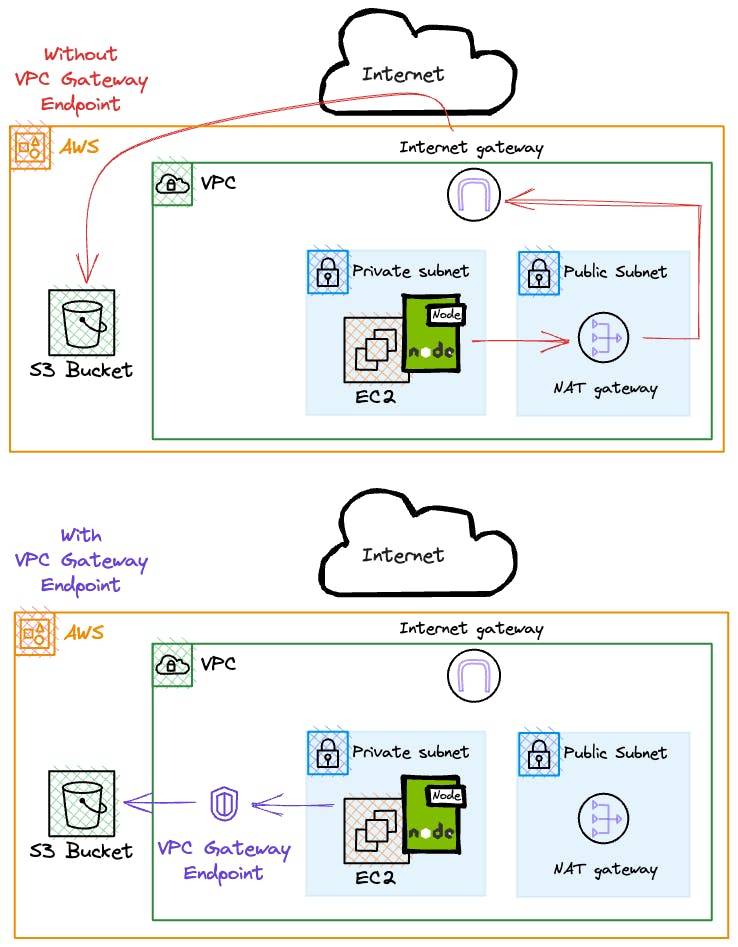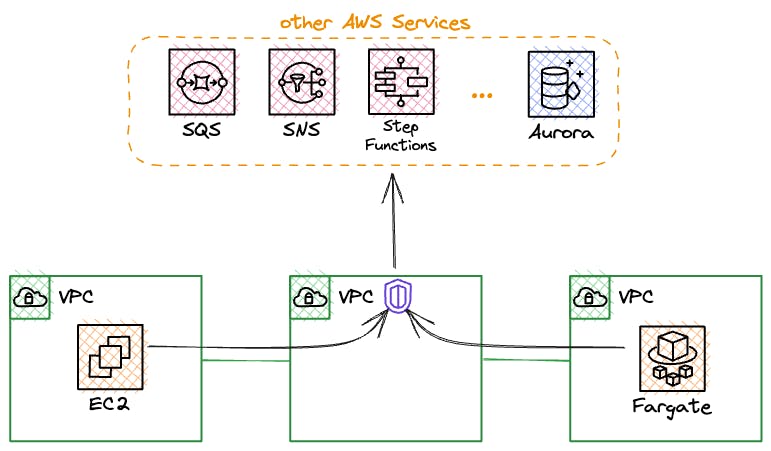VPC Endpoints offer a highly secure and efficient method for connecting your AWS resources to specific AWS services, ensuring that your data remains within the AWS network, and minimizing exposure to the public internet.
In this comprehensive article, we will examine the two distinct types of VPC Endpoints, namely interface endpoints and gateway endpoints, delving into their unique attributes, advantages, and potential drawbacks.
Gain valuable insights on how to establish secure and direct access to AWS services by leveraging VPC Endpoints and enhancing your cloud environment's security and overall effectiveness.
What is a VPC Endpoint?
A VPC endpoint is a crucial network component that enables secure connectivity between resources inside a VPC and specific AWS services, eliminating the need for public IP addresses.
With a VPC endpoint, instances inside a private subnet of a VPC can seamlessly communicate within the AWS ecosystem without requiring a NAT device, VPN connection, internet gateway, or AWS Direct Connect.
This means resources do not need to leave the AWS network but the communication stays within a single region.
There are two distinct types of VPC endpoints:
Interface endpoints: These endpoints facilitate communication with a wide range of supported services and keep the traffic within the AWS cloud. As VPC interface endpoints utilize PrivateLink, you'll be charged for those endpoints by the hour and by the introduced data transfer.
Gateway endpoints: Designed for specific services, gateway endpoints also ensure traffic remains within the protected AWS network. Currently, only Amazon S3 and Amazon DynamoDB are supported. Gateway endpoints don't introduce any additional costs.
Understanding the differences and capabilities of these endpoint types is essential for effectively establishing secure and efficient connectivity within your VPC environment.
In-Depth Exploration of Both VPC Endpoint Types
Let us delve deeper into the distinctions and unique features of both endpoint types to gain a comprehensive understanding of their respective capabilities.
Gateway Endpoints
A gateway endpoint is designed to direct traffic to specific IP routes in an Amazon VPC route table, typically for accessing Amazon DynamoDB or Amazon Simple Storage Service (Amazon S3). Unlike interface endpoints, gateway endpoints do not facilitate AWS PrivateLink connections.

Instances within an Amazon VPC can communicate with VPC endpoints without the need for public IP addresses. Interface endpoints utilize local IP addresses within your VPC network. On the other hand, gateway endpoints serve as destinations accessible within an Amazon VPC through prefix lists specified in the VPC's route table.
In the given example, our application resides in a private subnet and only requires access to Amazon S3. In this situation, we can use a VPC endpoint to maintain the application's strict privacy while still granting it access to our files in S3. This eliminates the need for a NAT gateway in a public subnet and also removes the necessity to redirect traffic through the internet gateway.
How to Set up Gateway Endpoints
To set up a gateway endpoint, you need to configure the following steps:
Choose the specific AWS service you want to connect to, either Amazon S3 or DynamoDB. This selection determines the type of endpoint you will create.
Select the VPC where you want to deploy the endpoint.
Identify the route table(s) within the chosen VPC that will be associated with the endpoint. These route tables will receive the necessary destination information to allow access to the AWS service through the endpoint.
Define an access policy for the endpoint. This policy specifies the resources (such as S3 buckets or DynamoDB tables) that can be accessed and the actions that can be performed by components within your subnets. It helps control and restrict access to the AWS service.
Verify that the VPC security group associated with your resources includes a rule allowing outbound traffic from the VPC to the specified service (S3 or DynamoDB). This rule is crucial for enabling traffic to flow through the gateway endpoint and ensures that your components can communicate with the AWS service effectively.
By following these steps, you can successfully set up a gateway endpoint and establish a secure and controlled connection between your VPC and the desired AWS service.
Interface Endpoints
Interface endpoints enable secure and private connectivity to various services through AWS PrivateLink. These services encompass AWS managed services, endpoint services hosted by other AWS customers and partners in their Amazon VPCs, and supported AWS Marketplace partner services. Service providers own the benefits, while service consumers create and use interface endpoints to access those services.

An interface endpoint acts as an entry point for traffic directed towards a supported service and consists of one or more elastic network interfaces with private IP addresses. Interface endpoints currently support numerous AWS-managed services.
How to Set up Interface Endpoints
To create a new interface endpoint, follow these steps:
Specify the name of the AWS service or endpoint service that you want to establish private connectivity with.
Create a network interface (ENI) and select the desired subnet to associate with the interface endpoint.
The endpoint network interface will be assigned a private IP address from the IP address range of the selected subnet.
This private IP address will remain allocated to the interface endpoint until it is removed.
By utilizing this private IP address, traffic can be confined within the Amazon network without requiring any changes to the route table.
By following these steps, you can successfully create a new interface endpoint and ensure private connectivity with the desired AWS service or endpoint service.
As mentioned before, keep in mind that you're charged for interface endpoints.
Benefits of VPC Endpoints
VPC Endpoints offer enhanced security by keeping traffic within the AWS network, reducing exposure to the public internet. They also help reduce data transfer costs by eliminating the need for data to traverse over the internet, and improve performance by providing low-latency access to AWS services.
Potentially Lower Latency
Routing traffic through the public internet introduces the possibility of increased latency. However, if all services remain within the same AWS region, the latency can be either the same or even faster.
No Need for Configuring Additional Outbound Firewall Rules
This method requires implementing outbound firewall rules, such as IP or domain allow-lists. This process can become cumbersome as you need to know the specific domains and IP addresses in advance. Debugging and properly configuring these rules can be time-consuming and frustrating.
Reduced Data Fees
If you rely on a managed NAT Gateway, AWS charges data processing fees for egress traffic. This cost can be particularly significant when dealing with vast amounts of data, like at Amazon S3.
Less Attacking Surface and Security Risks
When accessing your customer's data stored in DynamoDB from within your application, it is of utmost importance to ensure that the traffic remains within the AWS network. Allowing the data to leave the AWS network poses a significant security risk that could compromise the confidentiality and integrity of the information.
Enhanced Compliance and Governance
Depending on your industry or regulatory requirements, using public internet routing may not meet compliance standards. VPC endpoints offer a more controlled and compliant environment for accessing AWS services.
Conclusion
In conclusion, VPC Endpoints provide a highly secure and efficient method for connecting AWS resources to specific services within the AWS network.
This article has explored the two types of VPC Endpoints: interface endpoints and gateway endpoints. Interface endpoints enable private connectivity to a wide range of supported services using AWS PrivateLink, while gateway endpoints are designed for specific services like Amazon S3 and Amazon DynamoDB.
By understanding the capabilities and differences between these endpoint types, you can establish secure and efficient connectivity within your VPC environment. VPC Endpoints offer benefits such as enhanced security, reduced data transfer costs, potentially lower latency, simplified outbound firewall rules, reduced security risks, and enhanced compliance and governance.
By leveraging VPC Endpoints, you can enhance the security and effectiveness of your cloud environment by establishing secure and direct access to AWS services.
Frequently Asked Questions
What are the two types of VPC Endpoints?
Interface endpoints and gateway endpoints are the two types of VPC Endpoints.Which AWS services are currently supported by gateway endpoints?
Amazon S3 and Amazon DynamoDB are the only services currently supported by gateway endpoints.What is the primary purpose of a VPC Endpoint?
A VPC Endpoint enables secure connectivity between resources inside a VPC and specific AWS services, eliminating the need for public IP addresses.What are the main benefits of using VPC Endpoints?
Some benefits include enhanced security, reduced data transfer costs, potentially lower latency, and improved compliance and governance.Are there any limitations or considerations when using VPC Endpoints?
Region-specific availability, service support, and the potential impact on the design and architecture of your VPC should be considered when using VPC Endpoints.

